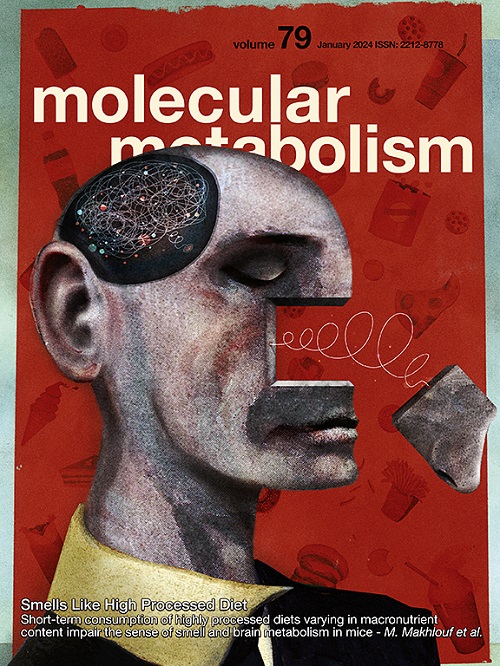LOX-1重组谷氨酰胺代谢,驱动肝纤维化。
IF 7
2区 医学
Q1 ENDOCRINOLOGY & METABOLISM
引用次数: 0
摘要
目的:肝纤维化是评价慢性肝病预后的重要条件。凝集素-1样氧化低密度脂蛋白受体-1 (LOX-1)在不同的纤维化疾病中显示出潜在的研究价值和治疗靶向可能性。然而,LOX-1在肝纤维化进展中的作用及其潜在机制尚不清楚。方法:检测肝纤维化患者及啮齿动物肝组织中LOX-1的表达。用CCl4或蛋氨酸胆碱缺乏饮食(MCD)诱导LOX-1基因敲除大鼠肝纤维化。通过转录组学和代谢组学分析探讨LOX-1在肝纤维化中的作用及其机制。结果:我们发现LOX-1通过促进肝星状细胞(hsc)的活化而加重肝纤维化。LOX-1缺失逆转了肝纤维化的发展。我们进一步证实,LOX-1通过介导谷氨酰胺酶(GLS)的异构体转换,重编程谷氨酰胺代谢,从而驱动肝纤维化。在机制上,我们揭示了LOX-1/OCT1/GLS1轴在肝纤维化发病机制中的关键作用。此外,LOX-1通过调节谷氨酰胺代谢-尿素循环来重新连接氨代谢,从而推动肝纤维化的进展。结论:我们的研究结果揭示了LOX-1在肝纤维化进展中的关键作用,丰富了LOX-1调节肝氨代谢的病理意义,为肝纤维化的治疗策略提供了有希望的靶点,显示了靶向LOX-1在抗纤维化治疗中的潜在临床价值。本文章由计算机程序翻译,如有差异,请以英文原文为准。

LOX-1 rewires glutamine ammonia metabolism to drive liver fibrosis
Objective
Liver fibrosis is a crucial condition for evaluating the prognosis of chronic liver disease. Lectin-1ike oxidized low density lipoprotein receptor-1 (LOX-1) has been shown potential research value and therapeutic targeting possibilities in different fibrotic diseases. However, the role of LOX-1 and the underlying mechanisms in liver fibrosis progression remain unclear.
Methods
LOX-1 expression was detected in liver tissues from patients and rodents with liver fibrosis. LOX-1 knockout rats were subjected to CCl4 or methionine and choline-deficient diet (MCD) to induce liver fibrosis. Transcriptomic and metabolomics analysis were used to investigate the involvement and mechanism of LOX-1 on liver fibrosis.
Results
We found that LOX-1 exacerbated liver fibrosis by promoting hepatic stellate cells (HSCs) activation. LOX-1 deletion reversed the development of liver fibrosis. We further verified that LOX-1 drove liver fibrosis by reprogramming glutamine metabolism through mediating isoform switching of glutaminase (GLS). Mechanistically, we revealed the crucial role of the LOX-1/OCT1/GLS1 axis in the pathogenesis of liver fibrosis. Moreover, LOX-1 rewired ammonia metabolism by regulating glutamine metabolism–urea cycle to drive the progression of liver fibrosis.
Conclusions
Our findings uncover the pivotal role of LOX-1 in the progression of liver fibrosis, enrich the pathological significance of LOX-1 regulation of hepatic ammonia metabolism, and provide an insight into promising targets for the therapeutic strategy of liver fibrosis, demonstrating the potential clinical value of targeting LOX-1 in antifibrotic therapy.
求助全文
通过发布文献求助,成功后即可免费获取论文全文。
去求助
来源期刊

Molecular Metabolism
ENDOCRINOLOGY & METABOLISM-
CiteScore
14.50
自引率
2.50%
发文量
219
审稿时长
43 days
期刊介绍:
Molecular Metabolism is a leading journal dedicated to sharing groundbreaking discoveries in the field of energy homeostasis and the underlying factors of metabolic disorders. These disorders include obesity, diabetes, cardiovascular disease, and cancer. Our journal focuses on publishing research driven by hypotheses and conducted to the highest standards, aiming to provide a mechanistic understanding of energy homeostasis-related behavior, physiology, and dysfunction.
We promote interdisciplinary science, covering a broad range of approaches from molecules to humans throughout the lifespan. Our goal is to contribute to transformative research in metabolism, which has the potential to revolutionize the field. By enabling progress in the prognosis, prevention, and ultimately the cure of metabolic disorders and their long-term complications, our journal seeks to better the future of health and well-being.
 求助内容:
求助内容: 应助结果提醒方式:
应助结果提醒方式:


